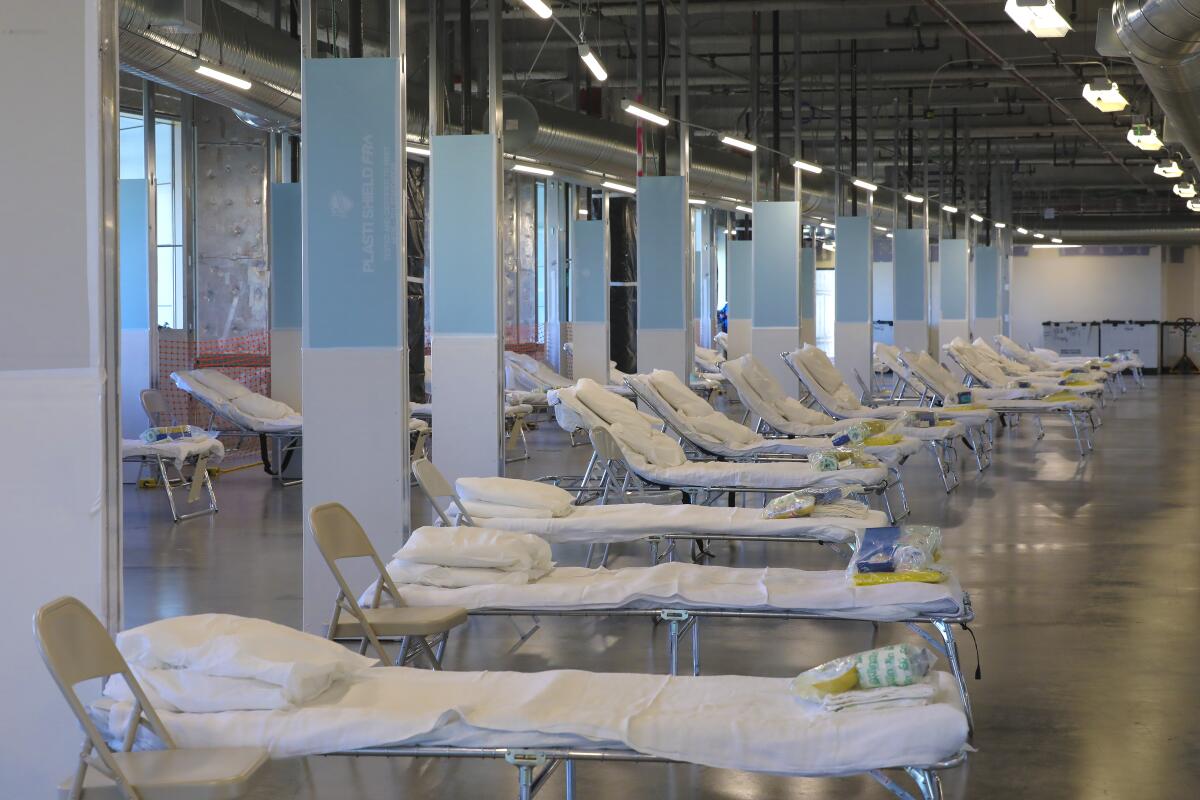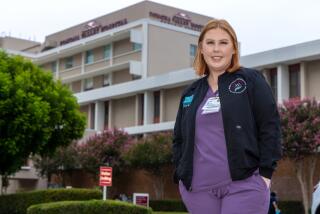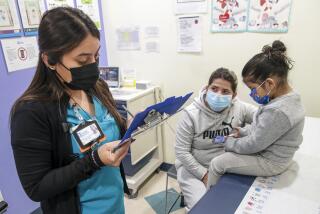California health officials scramble to staff medical facilities amid COVID-19 surge

- Share via
SACRAMENTO — California is scrambling to find enough nurses, doctors and other medical staff for the increasing demands of the unrelenting pandemic, with the state having so far acquired just one in 10 temporary contracted positions needed to treat surging caseloads.
Meanwhile, the state’s Health Corps, created by Gov. Gavin Newsom’s administration in March, has been unable to provide the help needed to make up the difference, with only a small fraction of the thousands of people who signed up for the volunteer service available to staff overloaded facilities.
To address the shortage, Newsom said Tuesday that California is “looking overseas” for additional staffing because other states are “in a similar predicament” to California and can’t spare their own healthcare workers.
“Staffing has gone to places that started surging a month and a half ago,” said Joanne Spetz, an associate director of research at Healthforce Center at UC San Francisco, which produces supply-and-demand forecasts on registered nurses in the state. “That makes our scramble harder.”
Newsom said the state needs to hire 3,000 temporary contracted medical workers to meet increasing demands. California has 300 of those currently working, he said Tuesday. The state also has 186 medical staff members deployed from the California National Guard and the California Medical Assistance Teams and has submitted requests to the federal government for medical personnel.
The California Health Corps has just 21 people currently helping with the surge in COVID-19 cases, a small number considering the thousands of people who signed up for the program after it launched to great fanfare in the spring, when Newsom initially estimated that the program could add up to 37,000 healthcare workers.
Newsom said the need for additional hospital capacity and staffing was highlighted over the weekend when San Joaquin County ran out of ICU beds. He said he expected other parts of the state to run out of ICU beds this month.
“We are very close within the next week or so,” Newsom said Monday during a visit to Los Angeles.
Newsom has also renewed calls for healthcare workers to join Health Corps, which aims to recruit recently retired providers, those in the process of getting a medical license and students enrolled in medical or nursing school to help meet the crushing workloads of the COVID-19 pandemic. The Health Corps allows those workers to sign up for paid shifts in different parts of the state that are experiencing staffing shortages.
More than 94,000 people registered for the program, but most lacked the licenses needed to work in the medical field or did not follow up with necessary hiring paperwork. About 4,900 registrants ultimately were qualified to work in the spring, according to data from the state’s public health department. In recent weeks, Newsom said the Health Corps now has about 900 people who are able to be deployed.
When asked why there are only 21 Health Corps members working during the current surge, a state public health department spokesperson said Tuesday that the agency is looking for ways to optimize the use of the volunteer program.
Since the program was created, Newsom said Health Corps members have covered almost 3,000 shifts at 143 facilities.
State Sen. Richard Pan (D-Sacramento), a doctor who chairs the Senate Health Committee, said it’s understandable that Health Corps’ membership fell precipitously given the high demand for healthcare workers, particularly with high-paying temporary staffing agencies.
Pan said that Health Corps is an altruistic program whose actual usefulness is limited. But, he added, the state is rightfully emphasizing the “all hands on deck” need for medical professionals.
“Staffing is a huge challenge right now and that’s probably our biggest limiting issue,” Pan said. “Before, in the spring, we were all worried about how many ventilators we have, but if you don’t have the staff to operate the ventilators that’s a problem.”
California has contracted with two staffing agencies to hire temporary workers.
In April, the California Department of Public Health inked a deal with Medefis, a Nebraska-based company that maintains a national database of healthcare professionals for hire. When that contract expired in September, it was extended through June 2021 for up to $50 million. To date, the state has paid $15.1 million to Medifis.
The public health department also signed a six-month contract through September with the healthcare staffing firm Aya Healthcare. That contract was extended through June 2021 for up to $50 million. California has so far paid $7.3 million to Aya Healthcare.
Aya Healthcare reported surging demand for travel nurses across the country, with 29,000 open positions. In just the past month, the company said there has been a 92% increase in hospital systems posting urgent job requests. California tops the company’s list as the state with the most staffing requests deemed urgent, according to Aya Healthcare data.
“There’s tremendous demand,” Pan said. “This is not a California-only problem. We are competing with every other state. Our country is one entire hotspot. There is no place to draw staff from.”
California has 11 designated overflow facilities across the state that can be used when hospitals become too full, which allow for an additional 1,668 beds if needed. In most cases, those sites would be used for less serious illnesses and injuries in order to ensure hospitals have enough beds for the sickest patients.
But although the state has the space and equipment to add those beds when needed, staffing has presented a new challenge compared with the first surge in COVID-19 cases during the spring.
Dr. Mark Ghaly, the California Health and Human Services secretary, said typically California would turn to staffing agencies for those kinds of needs.
“Those registries are being used throughout the nation,” Ghaly said Tuesday. “We’re only getting a small percentage [of requests for temporary workers filled]. Usually, we get close to 100% of our requests. We’re lucky to get two-thirds at the moment.”
Five of the state’s alternative care sites have been opened, including one on Monday at the Fairview Developmental Center in Orange County. That facility, which has a total capacity of 180 beds, has 10 beds considered active, with eight patients being treated there. In addition, Porterville Developmental Center in Tulare County has opened 10 beds for use, and the site can add an additional 113 beds.
Last week, a site was opened at Sleep Train Arena, the former home of the NBA’s Sacramento Kings. That care site, which has 20 beds available and a capacity of up to 244 beds, is currently treating seven patients. An additional 23 patients have filled available beds at Imperial Valley College, which has space for an additional 100 beds. The state also has a site for patients from the California Department of State Hospitals, which has 43 of 46 available beds filled to treat patients.
The remaining six sites could begin offering beds in the coming days and weeks as COVID cases continue to trend upward. Ghaly said two weeks ago that California was averaging around 15,000 cases a day, a number that has since more than doubled.
“That should tell you that in the next couple of weeks what our hospitals will be facing, the amount of people knocking on the front door with COVID to the emergency room departments that need an in-patient hospital bed, that might need that ICU bed, are going to increase,” Ghaly said.
More to Read
Sign up for Essential California
The most important California stories and recommendations in your inbox every morning.
You may occasionally receive promotional content from the Los Angeles Times.











